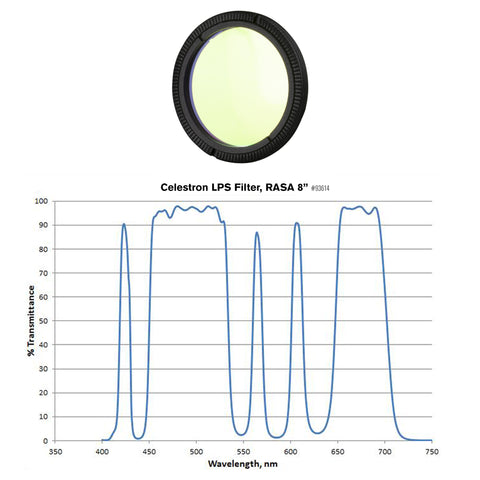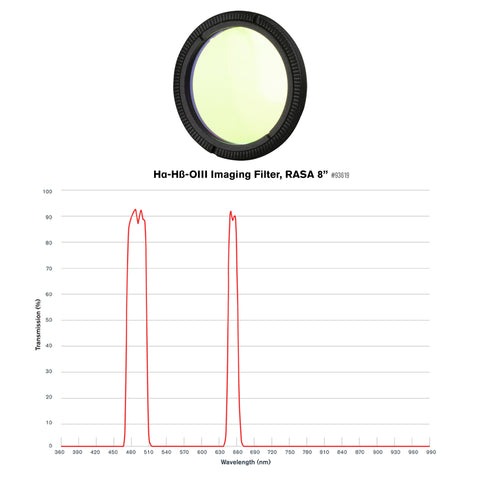
Celestron 8” Rowe-Ackermann Schmidt Astrograph (RASA 8) Imaging Kit
Manufacturer Part # 91079

Manufacturer Part # 91079
This special kit also includes the Celestron Light Pollution Imaging Filter and the Celestron H-Alpha, H-Beta, and OIII imaging filter.
This Celestron 8" f/2 Rowe-Ackermann Schmidt Astrograph (RASA) optical tube has:
Very fast 8" f/2 Rowe-Ackermann Schmidt optics
StarBright XLT optical multicoatings for the highest possible light transmission
MagLev DC cooling fan and cooling vents
Built-in corrector lens
Mirror locks
42mm T-thread and C Thread camera adapters
CGE (Losmandy-style "D-plate") dovetails
2-year warranty
"I don't get it. What do you look through?"
This might be the most common question people ask when you unpack your new Celestron Rowe-Ackermann Schmidt Astrograph (RASA). It's not only missing something that comes with virtually every telescope ever produced . . . an eyepiece . . . it doesn't even have a place to put an eyepiece. That's because the 400mm focal length f/2 Celestron 8" RASA is strictly a deep space imaging scope and cannot be used visually.
But what an imaging scope! It has a 22mm image circle that can handle CMOS cameras, smaller CCD cameras, and mirrorless cameras. The telescope does not work with standard DSLR cameras. It provides a proven Schmidt corrector optical system with a built-in corrector lens that keeps the images free of coma, field curvature, and false color. The optical quality and spot size across the entire image circle are unprecedented for an astrograph in this price range - or even that of a much more expensive instrument.
Its fast, wide field, f/2 optics give you two huge advantages over traditional f/10 catadioptric imaging scopes (even those using an optional f/6.3 or f/7 focal reducer). Those advantages? Better apparent tracking due to the image scale, plus shorter exposure times due to the speed of the optics. That means you can create better-looking deep space images in a fraction of the time it used to take, even without using an autoguider.
The Celestron RASA concept was to modernize the Celestron Schmidt camera, an instrument that had a loyal following, as its very fast focal ratio allowed amateur astrophotographers to produce wide field deep space images in the 1970s. Schmidt cameras could produce great images, but they wre and imaging scope only a really hard-core astrophotographer could love.
Those Schmidt cameras used a single frame of 35mm film, cut from a roll of film. You flexed the chip of film in total darkness (being careful not to touch the emulsion side) to fit snugly into a curved holder that matched the camera's curved focal plane, then loaded it into the camera by feel inside a black cloth bag to avoid image-spoiling stray light. You manually guided your scope during the entire exposure, keeping your eye glued to the crosshairs of an illuminated reticle eyepiece so your stars wouldn't turn into elongated squiggles. Finally, after a sometimes multiple hour single exposure, you tediously processed the small chip of film in your own darkroom before you could even begin to see if you had captured a usable image.
No more. Telescope mount drive accuracy has improved tremendously, electronic eyeballs have taken over guiding, and fast digital photography has taken the place of slow 35mm film.
Today's CCD camera can have sensors as large, if not larger, than film. To compensate for the new large sensors Celestron had to push the boundaries of the Schmidt camera design and make an entirely new type of instrument. The Celestron Rowe-Ackermann Schmidt Astrograph has provided that advance in the performance of deep space imaging scopes. With it, today's amateur astrophotographers can produce results rivaling that of the best professional observatory photos of only a few short years ago.
As with most advances in optics, the Celestron Rowe-Ackermann Schmidt Astrograph was designed not by committee, but by two dedicated optical experts who believed things could be done better - Dave Rowe and Mark Ackermann.
Dave Rowe - amateur astronomer, telescope maker, and optical designer - studied astronomy and astrophysics at Caltech, has published more than 50 papers, and holds 15 patents. Rowe has designed and fabricated many telescopes for Celestron and PlaneWave Instruments, including PlaneWave's corrected Dall-Kirkham and CDK700 telescope. He also worked closely with Celestron engineers in the development of the unique StarSense technology.
Mark Ackermann - amateur astronomer and experienced optical designer - earned a BS in mathematics and physics from the United States Air Force Academy, an MS in solid state physics, and a PhD in nonlinear optics from the University of New Mexico. He has published dozens of papers on optical telescope design and holds six US patents related to optical systems.
Engineered as a complete astroimaging system, every component of the Celestron Rowe-Ackermann Schmidt Astrograph is optimized for peak performance with CMOS, smaller CCD camers, and mirrorless cameras. Every component of the system has been designed to work together seamlessly, right down to the thickness of the glass used in the scope's fully-multicoated optical window.
Some of the advanced features of the Celestron 8" RASA includes mirror locks hold your precise focus. A quiet high-output 12V internal MagLev fan on the rear cell reduces cooldown time and provides optimal airflow through the dust filtered 24.7" long optical tube. Naturally, industry leading StarBright XLT optical multicoatings are standard equipment for the highest possible light throughput. A Losmandy-style "D-plate" dovetail is standard. The back focus with the included camera adapters is 25mm.
Along with the RASA 8" optical tube, this kit also includes the H-alpha H-beta OIII Imaging Filter and the Light Pollution Imaging Filter. This kit maximizes your RASA 8" telescope's potential to capture stunning images under any sky conditions, ensuring precise targeting of specific celestial objects and optimal light transmission.
Light Pollution Imaging Filter - This broadband filter effectively blocks specific wavelengths of artificial light while allowing the desired wavelengths of light emitted by celestial objects to pass through. When you add this filter to your RASA, you'll see vibrant, detailed celestial objects that "pop" against a dark sky background with excellent overall contrast. This filter blocks light from some of the most common sources of artificial and natural light pollution between 400 and 700 nm (i.e., the visible spectrum), including high- and low-pressure sodium-vapor streetlights, mercury-vapor streetlights, and natural airglow caused by oxygen in the atmosphere.
Unlike some light pollution filters, Celestron's filter blocks only specific areas of the spectrum instead of wide regions. This helps to maintain image brightness and color balance. In addition, particular wavelengths associated with emission nebulae, such as H-α (656nm), H-β (486nm), OIII (496nm and 501nm), and SII (672nm), are highly transmitted, ensuring minimal loss of image brightness for those objects.

H-alpha H-beta OIII (Hα-Hβ-OIII) Imaging Filter – The specialized Hα-Hβ-OIII Imaging Filter, also known as the Nebula Filter, is a narrowband filter that allows very high transmission of select wavelengths of light from emission nebulae while blocking the rest of the spectrum. You'll immediately notice much higher contrast in your images, even from your light-polluted backyard! And since the transmission at the critical wavelengths is so high, the nebulae are not dimmed—only the background is made blacker.
The Hα-Hβ-OIII Imaging Filter is perfect for imaging emission nebulae like the North America Nebula (NGC 7000), Lagoon Nebula (M8), Orion Nebula (M42), and the Carina Nebula (NGC 3372). The transmission spectrum for the Hα-Hβ-OIII Imaging Filter is 85% or greater at key wavelengths (486nm, 496nm/501nm, 656nm) and less than 0.5% transmission elsewhere. And while other nebula filters can't keep up with RASA's fast optics and end up blocking some of the the wrong wavelengths, this filter is engineered to pair perfectly with this ultra-fast f/2 system.

Both the Light Pollution Filter and the Hα-Hβ-OIII Imaging Filter are custom-engineered to work with RASA 8, so they won't block any of the "good" wavelengths, specifically targeting light pollution and other undesired wavelengths. The filters fit directly into the internal filter mount in RASA 8's front lens cell, where the optical window normally mounts. To use a filter, you first remove and replace the clear window with the desired filter. Since you are not introducing new layers of glass into the system when you swap out the window with the filter, you maintain RASA's exacting performance.
Each filter has a plastic storage case to safely store the filter or the optical window that came with your RASA when not in use. You will also receive a spectral transmission graph unique to each individual filter, verifying its performance.
| Camera | Compatible with RASA 8? | Adapter required |
|---|---|---|
| Astronomical CMOS/CCD camera with C-mount | Yes | C-mount adapter (included) |
| Astronomical CMOS/CCD camera with M42-thread mount | Yes | M42 adapter (included) with M42 extension tubes (not included) |
| Astronomical CMOS/CCD camera with other mount | Yes | Custom camera adapter |
| Canon mirrorless with APS-C sensor | Yes |
(sold separately) |
| Sony mirrorless with APS-C sensor | Yes |
(sold separately) |
| Canon mirrorless with full frame (42mm) sensor | Yes, but not optimized across the full sensor |
(sold separately) |
| Sony mirrorless with full frame (42mm) sensor | Yes, but not optimized across the full sensor | |
| DSLR | No | -- |
| Aperture | 8" |
|---|---|
| Focal Length | 400mm |
| Focal Ratio | f/2 |
| Heaviest Single Component | 17 pounds |
| Motorized Controls | n/a |
| Weight | 17 pounds |
| Optical Coatings | Starbright XLT |
| Resolution | .68 arc seconds |
| Supplied Eyepiece | n/a |
| Telescope Type | Schmidt-Cassegrain |
| Warranty | 2 years |
| Back Focus | 25mm |
Supplied Accessories:
M42 camera adapter, C-thread camera adapter, fan battery pack
{"one"=>"Select 2 or 3 items to compare", "other"=>"{{ count }} of 3 items selected"}